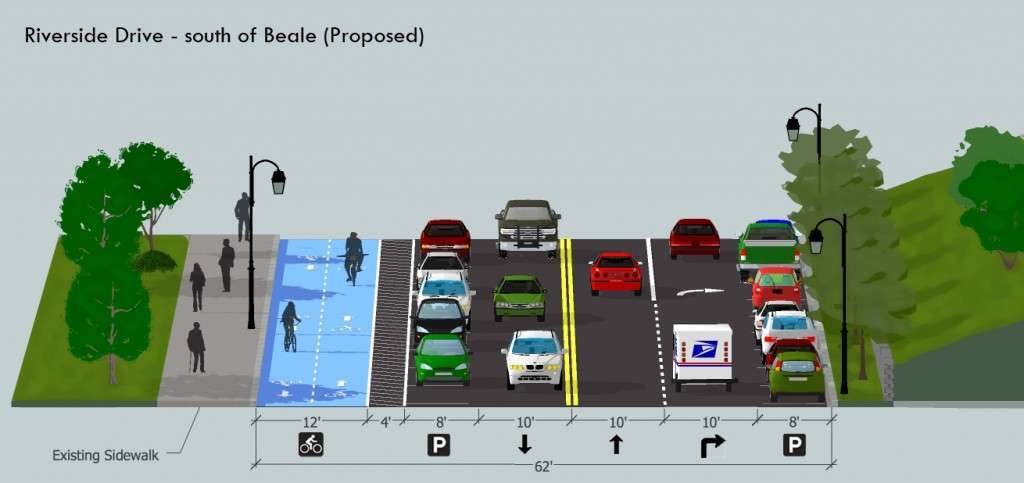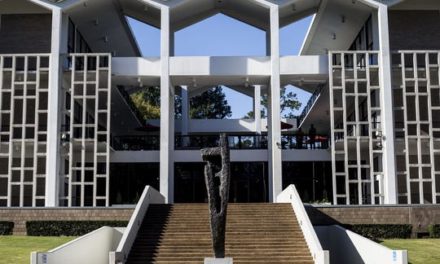Some things just baffle us.
First, there was the decision in 2014 by City of Memphis to close the western two lanes of Riverside Drive to traffic and designate them for bicyclists. For the cynical among us, there was the suspicion that the change in 2014 by the City Engineer’s Office was a way to provoke a public outcry and kill the experiment.
A year after it began, former Memphis Mayor A C Wharton pulled the plug, with the promise by the Engineer’s Office that it would reevaluate a way later to consider the addition of bike lanes.
Second, city crews surprised everyone when it repainted Riverside Drive earlier this year with no regard for bike lanes at all, frustrating bicyclists and livability advocates.
But what made both of these decisions confusing to us is because City of Memphis has had a design that it paid for since March, 2013, that adds bike lanes and parallel parking to Riverside Drive. It was developed by the respected transportation experts at Nelson-Nygaard, and the design was included in Jeff Speck’s 74-page report, Memphis Riverfront Analysis and Recommendations, which appears to have been sitting on a shelf since it was received by the Wharton Administration.
A Speck Of Hope
Mr. Speck drew liberally from the lessons in his last book, Walkable City: How Downtown Can Save America, One Step at a Time, and his experience as director of design for the National Endowment for the Arts and Director of Town Planning at Duany Plater-Zyberk and Co. He is the co-author of Suburban Nation: The Rise of Sprawl and the Decline of the American Dream as well as The Smart Growth Manual.
“Riverside Drive is the highway that was famously killed to become a parkway, but now functions too much like a highway, speeding cars in a seam between the city and its riverfront, We have the luxury of asking ourselves what kind of street Riverside Drive wants to be. Surely it can still hold cars, but the downtown would benefit tremendously if it were to hold cars moving a bit less speedily, alongside pedestrians and cyclists,” said Mr. Speck.
In answering his question about what the road wants to be, he wrote: “Riverside Drive, which is annually narrowed and closed with little negative impact on the downtown, should be converted from a four-lane speedway to a two-lane ‘complete street,’ including parallel parking and a protected bicycle track along the Mississippi River…Canopy trees should be added where they are lacking and can be planted at limited cost.
“The potentially easiest win on the Memphis riverfront is the reconfiguration of Riverside Drive. While a vast improvement over the interstate highway that was once planned for this corridor, it still functions much like a highway, moving four to five lanes of traffic speedily through downtown, creating a high-speed barrier that discourages pedestrian activity and river access. Landscape improvements along Tom Lee Park have already made it more attractive, but have not changed its non-pedestrian nature. Does Riverside Drive need to take such a strictly automotive form?
“The answer to this question can be found each May, when one-half of the street is closed for two weeks and the entire street is closed for three weeks. While presenting some temporary inconvenience as people adjust their paths, it is clear that the City’s grid of alternative north-south streets contains more than adequate capacity to absorb the trips typically handled by Riverside Drive. Such an experience has been mirrored in American cities from coast to coast, where highway removals have repeatedly failed to cause traffic crises. From New York’s West Side Highway to San Francisco’s Embarcadero Freeway, removed road capacity has not had a negative impact on travel times.”
A Plan To Consider
Following this year’s restriping, Memphis Public Works officials said that bike lanes on Riverside Drive “may be reevaluated” in the future, and we can only hope. It seems that a good place to start would be in the plan Memphis paid for and with a reevaluation of the Nelson-Nygaard design. The report proposed:
* To keep the two center travel lanes, as well as turn lanes at intersections, although these turn lanes should be shortened to the length of the typical queue;
* To replace the easternmost lane with parallel parking, clearly marked, and priced to encourage proper occupancy—approaching 80% around the clock. (During many times of day, that price will be $0.)
* To replace the westernmost lane with an ample two-way bike lane, separated by a painted buffer. This buffer should receive inexpensive breakaway metal posts at its center, each about 3 feet high, spaced about 20’ apart.
Giving Riverside What It Deserves
The report said: “This proposal is recommended for the entire stretch of Riverside Drive between Bass Pro Drive and Georgia Avenue. An alternative, compromise solution would not place parallel parking any further south than Tom Lee Park, but that solution would require a two-lane-to-one-lane northbound merge in this location. This transition is better handled at Georgia Avenue, where the right-hand lane can become a right-turn lane onto Georgia.
“Since the street varies in width along this stretch, and we wish to limit expense by not moving any curbs, the plans necessarily vary along their length. In all locations, however, two travel lanes are removed and replaced by a lane of parking to the east and a protected bike lane to the west.
“The parking lane receives its own buffer zone in some locations, so that the travel lanes maintain a proper width. The bike facility is located on the western flank because that edge is uninterrupted by intersections for its entire length, close to two miles. Such an uninterrupted path will be especially attractive to bikers, but it is essential that this route is clearly and safely connected to the larger regional biking system.
“Also in need of attention is the tree canopy over the Drive. While prettified in front of Tom Lee Park, it is still more decorative than sheltering. True urban boulevards are planted continuously with a single tall and broad species on both flanks and in the center. At maturity, the top branches of the trees touch, forming a dramatic ceiling. Memphis’ North Parkway, just west of I-240, shows what this configuration is like, and how effectively it contributes to the beauty and comfort of a space. Riverside Drive deserves no less.”
We Can Choose To Do It
Coincidentally (we think), today, we received an email from a young professional from Memphis who can live anywhere. She was in Pittsburgh, marveling at the landscape, streetscape, and quality of life, asking simply why can’t this be done in Memphis, particularly if we want to keep people with options to live anywhere. The answer of course is we can…if we choose to.
We thought of celebrated placemaker Gil Penalosa whose advice is that a city can change its character for the better by concentrating on what makes its livable and accelerating it to change city character. Founder and chair of Toronto-based 8-80 Cities and former Commissioner of Parks, Sport and Recreation for the City of Bogotá, Colombia, he said: “Every city should have a law of two words – pedestrians first.” “This principle in action means one thing. Livable cities start slowly. They start with traffic slowed down to 20 m.p.h. in neighborhoods to make pedestrians safe whether they are eight or 80 years old. Bike lanes are physically separated from roadways so people who would have never considered biking feel safe pedaling their toddlers to school.
“They have public spaces that celebrate public life, including parks where people can gather, play and rest. And they have clean, fast, public transportation that gives people choices about how to get around. When Gehl Architects founding partner Helle Søholt hears people say change is impossible culturally or financially for their city, she points out that even Copenhagen had to change culturally to be as livable as it is now, with downtown squares that once served as parking lots for commuters are now ringed with restaurants and retail, linked by commercially vibrant walking streets.
“Walkability is about designing streets for everybody and designing for pedestrians first – slow speeds, raised crosswalks, and next, make streets interesting for walkers. Bikeability isn’t about more Spandex – it’s a woman biking to a business meeting dressed exactly as if she were driving and the first step is to make bikers feel safe. Walkable streets and other public places are great equalizers; they bring people together, and they can energize people through recreation. Finally, high-speed buses with dedicated lanes are the most cost-effective way to move people, though offering choices to commuters is best of all.”
These may seem pipe dreams to many people in Memphis, but it’s being done in cities all over the U.S., and we’re hard-pressed to understand why Memphis can’t join them. To read more about Mr. Penalosa’s cornerstones of walkable, bikeable, livable cities, click here.
***
Join us at the Smart City Memphis Facebook page for daily articles, reports, and commentaries that are relevant to Memphis.






What’s most frustrating is that, in a city with so many seemingly intractable problems, we so often refuse to do correctly the things firmly within our control.
This is a great concept but Memphis will also have to learn to control other issues for it to result in a pleasant environment : cruisers and their noise have to be controlled – today they are not
Riverside Drive should be a showcase for the city. Unfortunately it is not. It’s an embarrassment. Poor design, poor upkeep and not a “complete street” as should be required in every street renovation project. It just mirrors how bad downtown has become.
It hurts to see our two tallest office building (100 N Main and Sterrick) empty and crumbling and Main Street falling apart and our trolleys and buses catching on fire and in horrible shape.
Mud Island was once a hope of promise for the riverfront and downtown but it’s now mostly weeds and also falling apart.
Like so many others, I’m depressed about the state of Memphis, especially downtown. Memphis is a city in steep decline.
The City Engineer’s office hostile to bicycle accommodation? I’m shocked, shocked! Oh wait, it was that same office, under a different head, that caused the city to lose out on a federal grant that would have paid for creating bike lanes, and to his credit, spurred AC Wharton to have the city pay to create what is now an amazing network of bike lanes. Maybe the new Mayor can follow in the old mayor’s footsteps and get Riverside Drive to realize its potential.
P.S. Don’t you get tired of people (more often than not, natives) who think, despite all the evidence to the contrary, that Memphis is “a city in steep decline?” Memphis’ biggest problem continues to be Memphians.
Martskers –
“Memphis’s biggest problem continues to be Memphians.” Amen, man. I grew up here, moved around the country for the past 10 years, and just recently moved back after a 3-year stop in Nashville. Memphis has momentum and coolness to spare, but it is also populated with more downers than any place I’ve ever been. I yawn every time 38120 posts on this forum. The city has problems, sure, but sitting on the sidelines and whining about it might be the most tired past time in Memphis.
In answer to your question, Martskers, yes, we do get tired of the Memphis in steep decline comments. Thanks, Will, for the great comments.
I would wholeheartedly agree that Memphis has very serious problems and doesn’t ever seem to tackle them properly. I would say we are STAGNANT and approaching a state of decline in many areas. People are just fed up with decades of incompetent politics, mismanaged projects and very little economic development. A lot of the stagnation is because of our high poverty and high crime. Riverside Drive, the problems downtown and our infrastructure issues just reflect these problems right at our front door.
AGREED with noise and cruiser issue. The city has the ability to create a law or rule regarding noise amplified from cars, and MPD could enforce it. I remember when I loved in Virginia, traveling down to VA Beach and getting two tickets in one night for blasting my radio to loud while “cruising” on the strip. After that, I never had that issue again.
Very unfortunate that Speck’s excellent recommendations on street configuration were not followed. Up to this point the leadership in Memphis has been very adept at obtaining master plans then shelving them permanently. On-street parking would be very helpful along the length of Riverside, would reduce the need for surface parking lots, would slow traffic, and would reduce people’s heart rates who cross from the park to the stairs up the bluff.. I can only guess that the Memphis Division of Engineering has a very East Memphis-centric vision of street design, which entails maximizing level of service over all other parameters (walkability, pedestrian safety, etc). As an example it was only through the advocacy of the DMC that a 4-way stop was able to be installed at Florida & Carolina near Loflin Yard. The ultimate solution may only be the creation of a true planning department and city master plan.
My biggest concern is safety, since when the bike lanes were installed along-55. Riverside Drive, it caused northbound traffic to back up on to I-55. This area is already dangerous with or without bike lanes, as the speed limit suddenly goes from 55mph to 35mph with multiple driveways and streets intersecting the road. Whatever design is chosen, it MUST not impede NORTHBOUND (previous post stated southbound in error) traffic where I-55 suddenly becomes Riverside Dr., otherwise, a tragedy is bound to occur.
The traffic going south around Beale St Landing with bike lanes was completely confusing, and the arrows for turning into the BSL parking lot if driving north only added to the confusion. Maybe a two way bike lane on the eastern lane of Riverside Dr could work, but the trial was doomed by Beale St Landing being located in the wrong place.
Martskers & Will Irvine
Amen! Preach on, brothers. There is a sense of optimism in our city that I’ve not witnessed… well, ever. It’s not coming from those who are willfully ignorant of the many good things going on here.